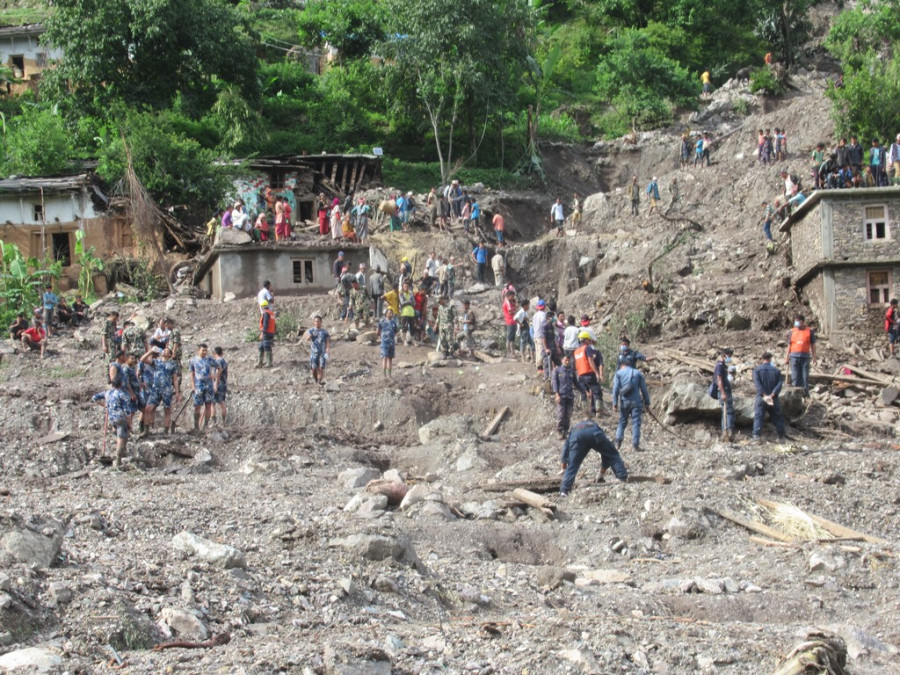Columns
Rhetoric and reality of Nepal’s disaster risk management
Sustainable funding to implement anticipatory action should come from local and provincial governments.
Damodar Kanel
Summer has had its time, and monsoon mayhem will make headlines for the next few months. This has continued for ages, and with a changing climate, it is likely to increase. We can’t stop monsoons from entering our territory, nor do we want to; they are the lifeline of Nepal’s agriculture, food security, biodiversity, water recharge and many more. We can’t modify its onset, spread and intensity. However, we would be keenly interested in knowing about its arrival, its impacts, its impact area, and its victims.
The progress in hydromet science allows us to forecast rainy days, hot days, cold days and many other hydromet phenomena with reasonable spatial and temporal accuracy. When combined or overlaid with exposure and vulnerabilities (poverty, house structures, settlement locations, etc.), forecasts can tell us who will be affected the most, where and when. This is possible through “impact-based forecast” (IBF).
So, why not use this knowledge and gear ourselves up to act whenever we have such information? Well, things have already begun, and it’s time to mainstream this approach to managing disaster risks. The “anticipation or anticipatory action” approach entails acting ahead of predicted hazards to prevent or reduce acute humanitarian impacts before they fully unfold. Anticipatory action, as such, is an integral part of disaster risk management, and it systematically links forecast information to actions that can help reduce disaster impacts and protect lives and livelihoods. When you have credible information about a hazard with its occurrence (time and location) reasonably known, there cannot be any excuse for inaction.
Since there are now reasonably accurate forecasts of many natural hazards, it is a matter of using forecast science and information in decision-making. Anticipatory action (AA) is yet to be fully integrated into risk management policies and practices in many countries. However, the intention is to make it an integral part of Disaster Risk Management (DRM) thinking and practice. Some operational challenges and “perceived” difficulties are associated with its integration. Here, I discuss some of those challenges in Nepal’s context.
First and foremost is the complexity of the narrative itself. Therefore, the first step is to simply demystify the narrative of anticipation—what it means and doesn’t. In Nepal, anticipatory action was first introduced as “forecast-based financing” (in 2015-16), where rainfall forecasts from the Department of Hydrology and Meteorology were used to inform and prepare organisations to respond better and quicker to looming floods. Somewhere during 2016-17, some of the Disaster Preparedness and Response Plans (DPRPs) and the national DRR Strategic Plan of Action also tried to incorporate anticipation.
Nevertheless, those initiatives remained ephemeral as they were marred with classical problems of being supply-driven and top-down and needing more compelling evidence. Furthermore, there was little investment in clarifying the approach, follow-up and communication, as well as strengthening capacities and building systems.
Second, to a larger extent, AA has been siloed within non-state actors (mainly with the I/NGOs, UN and donors) and has been limited to small-scale “pilots”. Though the National Disaster Risk Reduction and Management Authority (NDRRMA) is now taking it up, it has not yet been systematically integrated into the government's disaster risk management thinking and practice. Nepal needs a government-led process that brings actors together to agree on an operational framework, harmonise the approach, charter a pathway and milestones, and reinforce mutual accountability. NDRRMA should encourage actors to get out of their “minuscule pilots” and facilitate bigger and scalable impacts. In the meantime, the actors/stakeholders should join hands to support the government in developing and implementing plans for anticipation at scale for different hazards.
The obsession with quick wins and tangible results is another classical problem facing many donor-funded initiatives; AA is no exception. While such pursuits are soothing and pleasing, they do not always produce durable and sustainable solutions. Therefore, the donors must emphasise “building/strengthening systems” for anticipatory action through what they call the “build money”. The government needs to strengthen the systems, capacity and infrastructure for the governments to use weather forecasts as decision-support information. Meanwhile, the donor priority for anticipatory action mustn't crowd out funding for long-term preparedness, risk reduction and resilience building. Anticipatory action can be implemented at scale only through a robust disaster risk management system.
Sustainable funding for implementing anticipatory action should ideally come from the local and provincial governments. While the federal government, donors and non-state actors can support strengthening systems and capacities, the “fuel money” should come from the local governments, allowing for the implementation of anticipatory actions for imminent threats. The policy and legislative interventions/reforms should empower governments to earmark a portion of their coffer to act ex-ante and release funds for anticipatory actions based on the imminent threat of a hazard. This is not technical and administrative but rather political; it requires bold decisions, innovation and accountability.




 10.12°C Kathmandu
10.12°C Kathmandu















